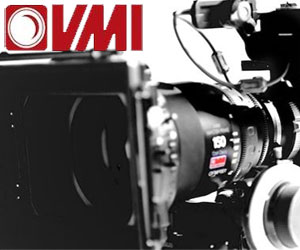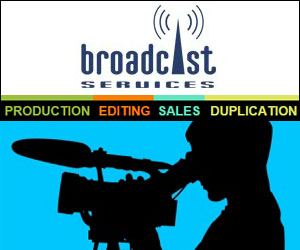Broadcast News
16/02/2016
It's All About The Sync

Ever experienced that frustrating moment when a director has the bright idea to call across another member of the camera team to cross shoot an item with a second camera at the last minute?
Or maybe there's a multi-camera unit and several single camera PSC crews filming on location for the same production. If the multi-camera team finishes ahead of schedule, they are now expected to grab their cameras and help out their PSC colleagues. I've definitely experienced this drive for efficiency first hand and seen how even the most established productions are adopting these flexible shooting practices. Wouldn't it be a relief to know that when this happens, without doubt, every source of video and audio is perfectly in sync?
From GoPros attached to goal posts, to SLRs cross-shooting alongside more traditional professional broadcast units, it may be relatively hassle-free to film from multiple and varied camera sources nowadays, but the real issue comes with how to sync them. Although it's possible to fix sync problems later in the edit suite, this is time consuming and expensive, which makes getting it right at the point of shooting a massive benefit to all productions, especially those on tight budgets or operating with short turnaround times.
When we launched the first Timecode Systems products back in 2012, it was the simplicity of our wireless timecode products that was refreshing. If a self-shooting camera arrives on location mid-way through the recording day, our users have the capability to simply attach one of our :mini trxs to the unit, select the right RF channel and get going knowing their recorded content will be instantly synced against an incredibly accurate master clock. And then when they arrive back on set the next day, they reset the master clock and everything is swiftly synced up again. Our products make it that simple.
This fast and simple set up means our products are designed to meet the needs of flexible shooting; but even more important is the integration of robust synchronisation that can withstand the challenges of a complex rig. In terms of avoiding drift and providing syncing points for post-production, wireless timecode is a great tool, but in more complex and changeable shooting set ups, productions often want even more accuracy and complete reliability when it comes to synchronisation. Major broadcasters are now routinely demanding timecode and genlocked cameras on multi-camera shoots. For this reason, as a company, we’re definitely seeing a rising interest in the unique wireless genlock and word clock syncing capabilities integrated into our timecode products. This is where our products come into play by offering the world's smallest and lightest timecode and genlock failsafe wireless system.
But syncing timecode is only part of the story. What is also emerging is the capability to use RF to synchronise metadata as well. The broadcast world is definitely waking up to the power of collecting, sharing and logging accurate, real time and impeccably synced data across the whole production team, completely wirelessly. Having seen what we can do with timecode, we've now got productions, camera manufacturers, edit software developers and a whole range of other broadcast professionals asking us what other workflow hassles our technology could resolve. This is leading to some exciting developments in workflow technology.
Late last year, we launched B:LINK, a new RF network that augments the company's tools for wireless timecode sharing. Originally, we used the long-range RF only for one-way timecode and genlock, but we knew that with development, we could make better use of the bandwidth and actually multiplex two-way communication in between the sync data. Our customers and integration partners were asking for the ability to control cameras and sound equipment as well as synchronise it. B:LINK satisfies these expectations. Now customers and partners can not only share timecode wirelessly but also control all devices on the network and gather more metadata wirelessly as well – which means fewer cables and greater convenience.
And the exciting thing for us is this is still only the start of where wireless workflow technology is heading. Streamlining media workflows is set to be one of the most prominent talking points in the broadcast industry in 2016. And we're thrilled to be at the forefront of these conversations.
Article by Paul Scurrell, managing director, Timecode Systems Limited.
www.timecodesystems.com
(JP/LM)
Or maybe there's a multi-camera unit and several single camera PSC crews filming on location for the same production. If the multi-camera team finishes ahead of schedule, they are now expected to grab their cameras and help out their PSC colleagues. I've definitely experienced this drive for efficiency first hand and seen how even the most established productions are adopting these flexible shooting practices. Wouldn't it be a relief to know that when this happens, without doubt, every source of video and audio is perfectly in sync?
From GoPros attached to goal posts, to SLRs cross-shooting alongside more traditional professional broadcast units, it may be relatively hassle-free to film from multiple and varied camera sources nowadays, but the real issue comes with how to sync them. Although it's possible to fix sync problems later in the edit suite, this is time consuming and expensive, which makes getting it right at the point of shooting a massive benefit to all productions, especially those on tight budgets or operating with short turnaround times.
When we launched the first Timecode Systems products back in 2012, it was the simplicity of our wireless timecode products that was refreshing. If a self-shooting camera arrives on location mid-way through the recording day, our users have the capability to simply attach one of our :mini trxs to the unit, select the right RF channel and get going knowing their recorded content will be instantly synced against an incredibly accurate master clock. And then when they arrive back on set the next day, they reset the master clock and everything is swiftly synced up again. Our products make it that simple.
This fast and simple set up means our products are designed to meet the needs of flexible shooting; but even more important is the integration of robust synchronisation that can withstand the challenges of a complex rig. In terms of avoiding drift and providing syncing points for post-production, wireless timecode is a great tool, but in more complex and changeable shooting set ups, productions often want even more accuracy and complete reliability when it comes to synchronisation. Major broadcasters are now routinely demanding timecode and genlocked cameras on multi-camera shoots. For this reason, as a company, we’re definitely seeing a rising interest in the unique wireless genlock and word clock syncing capabilities integrated into our timecode products. This is where our products come into play by offering the world's smallest and lightest timecode and genlock failsafe wireless system.
But syncing timecode is only part of the story. What is also emerging is the capability to use RF to synchronise metadata as well. The broadcast world is definitely waking up to the power of collecting, sharing and logging accurate, real time and impeccably synced data across the whole production team, completely wirelessly. Having seen what we can do with timecode, we've now got productions, camera manufacturers, edit software developers and a whole range of other broadcast professionals asking us what other workflow hassles our technology could resolve. This is leading to some exciting developments in workflow technology.
Late last year, we launched B:LINK, a new RF network that augments the company's tools for wireless timecode sharing. Originally, we used the long-range RF only for one-way timecode and genlock, but we knew that with development, we could make better use of the bandwidth and actually multiplex two-way communication in between the sync data. Our customers and integration partners were asking for the ability to control cameras and sound equipment as well as synchronise it. B:LINK satisfies these expectations. Now customers and partners can not only share timecode wirelessly but also control all devices on the network and gather more metadata wirelessly as well – which means fewer cables and greater convenience.
And the exciting thing for us is this is still only the start of where wireless workflow technology is heading. Streamlining media workflows is set to be one of the most prominent talking points in the broadcast industry in 2016. And we're thrilled to be at the forefront of these conversations.
Article by Paul Scurrell, managing director, Timecode Systems Limited.
www.timecodesystems.com
(JP/LM)
More Broadcast Equipment Stories
29/03/2019
360 Video Equipment
TX uses the widest possible range of 360 Degree Video Camera Systems to allow users to choose the perfect camera for their application, even in the ha
360 Video Equipment
TX uses the widest possible range of 360 Degree Video Camera Systems to allow users to choose the perfect camera for their application, even in the ha
11/06/2018
BFV's Big Interview: Finepoint Broadcast
Broadcast Film & Video exclusively talks to Giles Bendig, the Managing Director of Finepoint Broadcast. The firm has been supplying broadcasters with
BFV's Big Interview: Finepoint Broadcast
Broadcast Film & Video exclusively talks to Giles Bendig, the Managing Director of Finepoint Broadcast. The firm has been supplying broadcasters with
27/02/2018
BFV's Big Interview: TSL Products
For more than 30 years, TSL Products has worked directly with the world's leading broadcasters and content creators to design, manufacture and market
BFV's Big Interview: TSL Products
For more than 30 years, TSL Products has worked directly with the world's leading broadcasters and content creators to design, manufacture and market
14/12/2017
Camera Automation For Sky Sports' PDC Darts Championships Coverage
MRMC has been providing robotic systems for Sky Sports' coverage of the PDC darts championships for three years. Between the 2013 2016 seasons, the ro
Camera Automation For Sky Sports' PDC Darts Championships Coverage
MRMC has been providing robotic systems for Sky Sports' coverage of the PDC darts championships for three years. Between the 2013 2016 seasons, the ro
16/06/2017
BFV's Big Interview: Vortex
Based in Ealing, London, Vortex Communications has been delivering cost-effective solutions to broadcast and professional AV users since 1987. This mo
BFV's Big Interview: Vortex
Based in Ealing, London, Vortex Communications has been delivering cost-effective solutions to broadcast and professional AV users since 1987. This mo
14/06/2017
Tally Technologies Introduce TallyTec Pro
Tally Technologies has introduced the TallyTec Pro – a tally light and timecode transmission system designed for the professional live production mark
Tally Technologies Introduce TallyTec Pro
Tally Technologies has introduced the TallyTec Pro – a tally light and timecode transmission system designed for the professional live production mark
23/01/2017
Getting The Most Out Of Fibre
Thanks to its ability to transport broadcast signals quickly and smoothly over very long distances – much longer than copper – fibre has become as muc
Getting The Most Out Of Fibre
Thanks to its ability to transport broadcast signals quickly and smoothly over very long distances – much longer than copper – fibre has become as muc
20/01/2017
AJA Ships ROI-SDI Scan Converter
AJA Video Systems has started shipping its ROI-SDI scan converter. Bringing Region-of-Interest (ROI) controls for professional SDI sources into a port
AJA Ships ROI-SDI Scan Converter
AJA Video Systems has started shipping its ROI-SDI scan converter. Bringing Region-of-Interest (ROI) controls for professional SDI sources into a port
16/01/2017
Hamlet And Good To Go!
Hamlet had a successful 2016 with a great response to its latest modular matrix switch range launched at IBC. The Hamlet portables for base band and s
Hamlet And Good To Go!
Hamlet had a successful 2016 with a great response to its latest modular matrix switch range launched at IBC. The Hamlet portables for base band and s
16/01/2017
How To Use Autocue Effectively
Autocue, teleprompting, prompting. Rarely the first service on the production managers list, and yet, it's a piece of equipment which when paired with
How To Use Autocue Effectively
Autocue, teleprompting, prompting. Rarely the first service on the production managers list, and yet, it's a piece of equipment which when paired with














